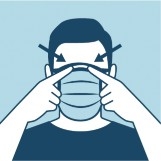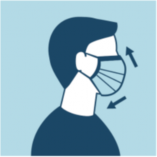Strategies to Control the Spread of COVID at Seafood Processing Plants: Hand Washing and Personal Protective Equipment
ID
FST-376NP
Hand Washing and Personal Protective Equipment (PPE)
Seafood processing plants can implement practices that will protect workers to exposure to SARS-CoV- 2, the virus that causes COVID-19, so that they are able to continue production while protecting themselves and others. By providing the necessary personal protective equipment and encourage frequent hand washing and the facilities to do so, processors and their employees can mitigate the spread of the COVID virus.
Wash Hands Often

- Wash hands often with soap and water for at least 20 seconds. Rinse and dry with a single use paper towel. If soap and water are not readily available, clean your hands with a hand sanitizer that contains at least 60% alcohol, preferably touch free.
- Companies should implement short breaks to allow employees to wash their hands more often.
- Install handwashing stations and/or (touch-free) hand sanitizers with at least 60% alcohol.
- Encourage the use of hand sanitizer by placing hand sanitizers closer to employee’s work, lunch room, and before entering high traffic areas.
Use of Personal Protective Equipment (PPE)

- When at work, use personal protective equipment (PPE) such as face mask, shield and gloves.
- Cover your mouth and nose with a facemask when around other people. The facemask is meant to protect other people in case you are infected. Continue to keep social distancing (6 feet) between yourself and others even when wearing a facemask.
- After use, PPE’s are contaminated and should be discarded at the end of the day. Used PPE is not to be taken home.
- If processing work is “sloppy” or may allow for food particles or water to reach your face, it is recommended to wear a face shield. However, continue to use the face mask while wearing the face shield.
 How to Wear a Face Mask
How to Wear a Face Mask

- Face coverings should fit snugly but comfortably against the side of the face.
- Be secured with ties or ear loops.
- Include multiple layers of fabric to allow for breathing without restriction.
- To prevent fogging when wearing glasses, put mask on first before glasses.
Processing Vessels

- Establish and ensure employees follow appropriate cleaning, sanitation, and disinfection practices.
- Provide personal protective equipment (PPE) and monitor their use.
Provide Education, Training, and Communication
- Teach workers about recognizing COVID-19 symptoms and how they may prevent exposure to the virus.
- Establish workplace programs to promote effective personal hygiene and use of PPE’s.
- Implement additional breaks to increase hand washing or hand sanitizer use.
- Increase access to PPE’s, tissues and touch-free trash receptacles.
Additional Resources
CDC 2020. Interim Guidance for Businesses and Employers Responding to Coronavirus Disease 2019 (COVID-19). https://www.cdc.gov/coronavirus/2019-ncov/community/guidance-business-response.html
CDC 2020. Protecting Seafood Processing Workers from COVID-19. Interim Guidance from CDC and the Occupational Safety and Health Administration (OSHA). Developed in consultation with the Food and Drug Administration (FDA). https://www.cdc.gov/coronavirus/2019-ncov/community/guidance-seafood-processing.html
Virginia Cooperative Extension materials are available for public use, reprint, or citation without further permission, provided the use includes credit to the author and to Virginia Cooperative Extension, Virginia Tech, and Virginia State University.
Virginia Cooperative Extension is a partnership of Virginia Tech, Virginia State University, the U.S. Department of Agriculture (USDA), and local governments, and is an equal opportunity employer. For the full non-discrimination statement, please visit ext.vt.edu/accessibility.
Publication Date
December 10, 2025



